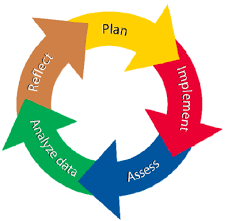Data Driven Change
- Daniel Argo
- Feb 25, 2023
- 2 min read
Altering The World of Assessments

Data driven instruction (DDI) is when data is used to drive instruction and assessment. Instructors use DDI from various types of assessments to measure how much their students are learning and understanding the material (Anonymous, 2023). Once data is collected, instructors can use it to adjust the teaching and materials to better fit the opportunities.

Assessments are undergoing a change in how they are implemented across academia. Data, gathered from smaller assessments, is being used as part of the teaching process and guiding instructors on what needs are to be addressed earlier in the timeline. DDI is beneficial when it is employed into the classroom effectively by the teacher (Bambrick-Santoyo, 2010). Teachers who use this data appropriately are able to adjust their instruction to better fill in the gaps of learning among their students.
Changes must take place in the classroom to truly benefit from the use of data. The implementation of new approaches in the classroom will lead to better teaching and a more engaging learning experience by the students (Bambrick-Santoyo, 2010). However, the teacher is not the only moving part in this scenario. There must be a cultural shift in all of academia and the shift to using data to influence assessments.
Administration must accept their role in the changing of curriculum and how assessments are given and a top down approach is essential when asking for a shift in how we use assessment data and instruction. Professional development and "buy in" are necessary for faculty during this transition, a culture change is at hand and it is not always a swift one (Bambrick-Santoyo, 2010).

Data driven instruction (DDI) is important to higher education as it will encourage more assessments over the course of the semester. Instructors, myself included, would benefit as it will push us to see our deficiencies in our instruction, and force us to evaluate our own methods. This would result in an updating of our material, curriculum, and instruction style to better fit with the modern student.
I need to gather more information on the benefits of DDI and how to better implement into my courses, either online or face to face. Understanding the basics of DDI and what changes need to happen will also allow me to present these benefits to colleagues in my department. As a coordinator and the person in charge of assessing out student outcomes, finding more robust methods of measuring student success over the semester would benefit the entire department.
Future Reference:
Works Referenced:
Anonymous. (2023, February 24). The Ultimate Guide to data-driven instruction (2023). Otus.com. Retrieved February 25, 2023, from https://otus.com/guides/data-driven-instruction/
Bambrick-Santoyo, P. (2010). Driven by data A practical guide to improve instruction. Jossey-Bass.


Comment written by: Francisco Sanchez for EDU6380
Hello Mr. Argo.
I can't entirely agree with your second to last paragraph. I appreciate that in courses like this, we, as EIT students, get to see perspectives from multiple layers of employment and education. While I agree with your statement that more assessments would allow professors to adjust their teaching, I am not confident that the updated courses would benefit modern students. For example, I recall taking calculus two in a traditional 16-week course. If we take the current educational zeitgeist of higher education, we would believe that students must now take the course in 8 weeks and must have multiple assessments and adjustments. Although I earned an A in my calculus…